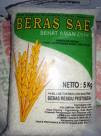Indonesia has the reached self-sufficiency of rice
Rabu, 04 Februari 2009
Rice is the major staple food for must of the Indonesian. The most striking impact of research over the past year ago is its contribution to the change in Indonesia’s rice production from the world’s largest importer of the major staple food to self-sufficiency. Increasing availability the seeds from new varieties, fertilizers and pesticides as well as favorable pricing policies influenced encouraged farmer to intensify their rice fields.
Indonesian farmers prefer to grow rice with good eating quality than select varieties for other characteristics such as high yield, early maturity, and resistance to certain pests and diseases. Therefore, only a few varieties are grow widely by farmers.
Increased production of palawija crops-food crops other than rice that includes corn, soybeans, peanuts, mungbeans, cassava, and sweet potatoes have been given a higher priority. One of the goals of agricultural development is to continue to obtain sufficient rice production, but at the same time substantially raise production of other crops to provide a more balanced diet for Indonesians and reduce costly imports. In addition, these crops play an important role as animal feed and raw material for industries.
The government hopes to reach self-sufficiency in these crops, especially corn and soybeans through intensification, densifications and diversification programmers. Production of corn and soybeans has begun to climb. Peanuts have shown a small increase but production of cassava and sweet potatoes has changed very little over the past years due mainly to marketing problem.Increased production of palawija crops-food crops other than rice that includes corn, soybeans, peanuts, mungbeans, cassava, and sweet potatoes have been given a higher priority. One of the goals of agricultural development is to continue to obtain sufficient rice production, but at the same time substantially raise production of other crops to provide a more balanced diet for Indonesians and reduce costly imports. In addition, these crops play an important role as animal feed and raw material for industries.




0 komentar:
Posting Komentar